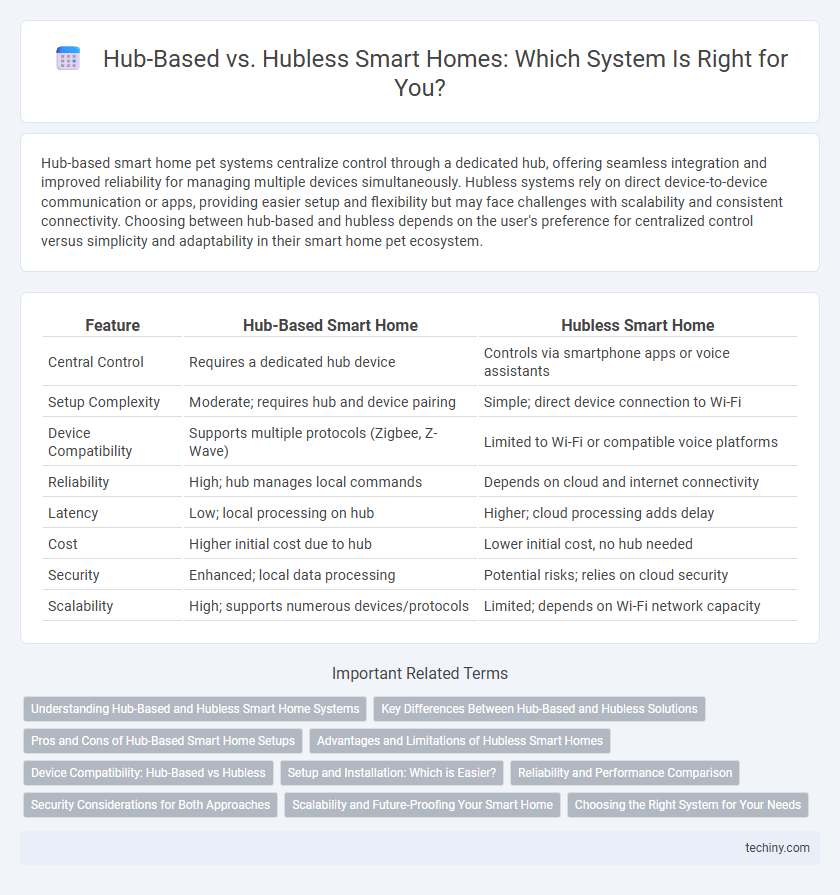Hub-based smart home pet systems centralize control through a dedicated hub, offering seamless integration and improved reliability for managing multiple devices simultaneously. Hubless systems rely on direct device-to-device communication or apps, providing easier setup and flexibility but may face challenges with scalability and consistent connectivity. Choosing between hub-based and hubless depends on the user's preference for centralized control versus simplicity and adaptability in their smart home pet ecosystem.
Table of Comparison
| Feature | Hub-Based Smart Home | Hubless Smart Home |
|---|---|---|
| Central Control | Requires a dedicated hub device | Controls via smartphone apps or voice assistants |
| Setup Complexity | Moderate; requires hub and device pairing | Simple; direct device connection to Wi-Fi |
| Device Compatibility | Supports multiple protocols (Zigbee, Z-Wave) | Limited to Wi-Fi or compatible voice platforms |
| Reliability | High; hub manages local commands | Depends on cloud and internet connectivity |
| Latency | Low; local processing on hub | Higher; cloud processing adds delay |
| Cost | Higher initial cost due to hub | Lower initial cost, no hub needed |
| Security | Enhanced; local data processing | Potential risks; relies on cloud security |
| Scalability | High; supports numerous devices/protocols | Limited; depends on Wi-Fi network capacity |
Understanding Hub-Based and Hubless Smart Home Systems
Hub-based smart home systems rely on a central device that manages communication between connected gadgets, ensuring seamless integration and enhanced security. Hubless systems operate through direct device-to-device communication, often leveraging Wi-Fi or cloud platforms for control, which allows for simpler setups but may face compatibility issues. Choosing between hub-based and hubless depends on priorities like scalability, device compatibility, and desired network reliability within the smart home environment.
Key Differences Between Hub-Based and Hubless Solutions
Hub-based smart home systems utilize a central hub to connect and manage multiple devices, offering improved device compatibility and centralized control. Hubless solutions rely on direct device-to-device communication through protocols like Wi-Fi or Bluetooth, enhancing simplicity and reducing potential single points of failure. Key differences include scalability, with hub-based systems better suited for large, complex setups, while hubless systems excel in ease of installation and minimal latency.
Pros and Cons of Hub-Based Smart Home Setups
Hub-based smart home setups centralize device control through a dedicated hub, enhancing compatibility and allowing seamless integration of diverse smart devices under one platform. This structure improves network stability and often provides better security features by local data processing compared to hubless systems. However, hub-based setups can be limited by the hub's range and may require additional hardware investment and setup complexity.
Advantages and Limitations of Hubless Smart Homes
Hubless smart homes offer the advantage of simplified installation and reduced upfront costs by eliminating the need for a central control hub, enabling devices to communicate directly via Wi-Fi or Bluetooth. However, limitations include potential connectivity issues due to device compatibility challenges and increased network congestion on home Wi-Fi systems, which can affect overall reliability and performance. The reliance on cloud-based processing may also raise privacy concerns compared to hub-based systems that manage data locally.
Device Compatibility: Hub-Based vs Hubless
Hub-based smart home systems offer extensive device compatibility by supporting various protocols like Zigbee, Z-Wave, and Wi-Fi, enabling seamless integration of diverse smart devices. Hubless systems rely solely on Wi-Fi or Bluetooth connectivity, which can limit compatibility to devices that support these standards natively. Choosing between hub-based and hubless depends on the variety and types of smart home devices users intend to integrate for optimal performance.
Setup and Installation: Which is Easier?
Hubless smart home systems offer easier setup and installation by connecting devices directly via Wi-Fi or Bluetooth, eliminating the need for a central hub and reducing complexity for users. Hub-based systems require installing and configuring a dedicated hub, which can provide better compatibility and centralized control but often demands more time and technical knowledge. For homeowners prioritizing quick and straightforward installation, hubless systems typically present a more user-friendly option.
Reliability and Performance Comparison
Hub-based smart home systems offer enhanced reliability through centralized control, minimizing latency and reducing potential connectivity issues between devices. Hubless systems rely on direct device-to-device communication or cloud-based management, which can introduce variability in performance due to network congestion or cloud service interruptions. Evaluating smart home setups, users often find hub-based solutions deliver more consistent responsiveness and stability, particularly in environments with numerous connected devices.
Security Considerations for Both Approaches
Hub-based smart home systems centralize device communication through a dedicated hub, enhancing security by allowing robust encryption and centralized firmware updates that protect against cyber threats. Hubless systems rely on cloud-based or direct device-to-device connections, which can increase vulnerability due to inconsistent security protocols across devices and dependence on internet connectivity. Evaluating security considerations requires assessing the reliability of the hub's encryption standards versus the potential exposure of hubless devices to external attacks and network breaches.
Scalability and Future-Proofing Your Smart Home
Hub-based smart home systems centralize device management, offering robust scalability by easily integrating multiple compatible devices through a single controller, which enhances seamless automation and consistent performance. Hubless systems rely on direct device-to-device communication or cloud services, allowing flexible expansion but potentially facing interoperability challenges and increased latency as the network grows. Prioritizing future-proofing involves choosing a platform with broad industry support, firmware update capability, and compatibility with emerging standards like Matter to ensure long-term scalability and seamless integration of new technologies.
Choosing the Right System for Your Needs
Hub-based smart home systems provide centralized control and improved device compatibility, making them ideal for larger setups with multiple connected devices. Hubless systems offer simplicity and ease of use, perfect for smaller homes or users seeking minimal installation and maintenance. Assess your home's size, preferred complexity, and device variety to select the optimal smart home solution.
Hub-based vs Hubless Infographic

 techiny.com
techiny.com